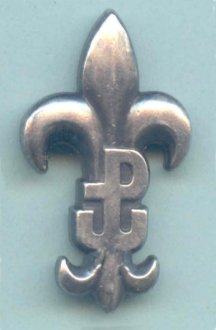
Badge of the "Grey Ranks"
Scout Field Mail
In the present reality of global access to information young people have no idea how huge, even as recently as a few years ago, was the role of mail and messages delivered by it.
The current commonness of mobile phones, the Internet, SMS, MMS, e-mails, Facebook, Twitter and Skype provides instant voice communication, exchange of written information or even audio-visual communication for billions of inhabitants of the globe. In this situation, the classic paper letters nearly completely went out of use.
One must remember, however, that a few hundred years ago a letter written on paper was the only way to communicate with other people.
Letters were delivered to the indicated addresses via horse messengers (urgent consignments) or mail stagecoaches. Communication between continents was held by merchant ships or special mail ships. This way of delivering letters made their topicality rather problematic.
Approximately 170 years ago the wire telegraph was invented which allowed sending messages through the Morse code. Approximately 130 years ago the limited use of wired telephony began. The instalment of underwater cables about 140 years ago made telegraph and telephone connections between the continents possible. At the beginning of the twentieth-century radio transmitters which allowed to send information written in Morse code as well as in the phonics version were introduced.
All these devices had limited availability and were used only by the military or large companies. Societies were primary using correspondence through letters delivered by mail.
During the times of war, the army used field mail providing military units and soldiers with correspondence with their superiors, civilians, and soldiers. In battle conditions, letters were subjects of certain rigour. The size of correspondence was limited, the contents of the letters were open for inspection and censorship. Letters were not charged with money. Military units' codes and special stamps were used in place of addresses and postal stamps.
After the outbreak of the Warsaw Uprising in 1944 the city was surrounded by a ring of German troops which also separated districts from each other. Insurgent units had difficulties in communicating with each other, the civilian population was virtually deprived of this communication. Regular mail, controlled during the occupation by the Germans, ceased to function, telephones were cut off.
To be able to communicate easily an attempt was made to create a military telephone network. In order to secure connection, the cables were placed even in the canals. Sparse short-wave radio stations were also used. Sometimes long-range, long-wave radio stations were used to establish contact between districts using indirect receivers installed in close proximity to London or Italy.
The most popular form of transmitting the reports and information between insurgent troops was the service of combat messengers which were mostly young boys and girls, often scouts, carrying open and secret reports risking their lives under enemy fire. Many of them died or were injured during this difficult and responsible service.
Most of the civilians of Warsaw were not aware of the upcoming outbreak of uprising at 5 o'clock on the 1st August 1944. The life of the capital city was on its regular track. Tens of thousands of people which have been cut off from their beloved ones and homes found shelter in adventitious houses. During the fights, civilians would often move to the other districts fleeing from the terror of coming German troops. From the first days of the uprising, the moods of the inhabitants of Warsaw were dominated by the feeling of anxiety about the fate of their relatives intensified by the lack of information about them. This concerned both civilians as well as soldiers fighting on the barricades.
This situation created an urgent need to establish a well-functionating field mail protecting the flow of information in the fighting city. During the occupation, there was a functionating field mail in the Polish lands operated by the Home Army. It was a secret organisation which was not servicing the needs of the civilian population.
The launch of field mail was anticipated in case of the outbreak of the uprising in the Warsaw District of Home Army. Mjr. Maksymilian Broszkiewicz a.k.a. "Embicz" was chosen as the head of the leadership of Field Mail. Since the whole city was not taken by the insurgents by the end of 1st August many of the fighting centres have become isolated and a part of Warsaw districts was quickly taken over by the Germans resulting in severe complications and a lack of coordination in Home Army's quartermaster's service. Admittedly at Szpitalna 4/9, a field mail troop was created but not many people knew about its existence. In order to meet the circumstances, the initiative of a well-functionating field mail was taken over by scouts.
The pre-war Polish Scouting Association went underground during the siege of Warsaw in 1939. The boy-scouts received the code name "Szare Szeregi" ("Grey Ranks") while the girl-scouts become the "Związek Koniczyn" ("Clover Alliance"), later changed to "Bądź Gotów" ("Be Ready"). "Szare Szeregi" were very active during the occupation by conducting various sabotage actions.
The rapid growth of "Grey Ranks" resulted in the creation of three levels for each age group. The oldest scouts exceeding 18 years old were included in the Assault Groups ("Grupy Szturmowe") (GS), boys aged 15 to 17 were a part of Warfare Schools ("Bojowe Szkoły"). In August 1943 the group of 75 people forming the "Agat" squad was separated from Assault Groups, the seed of later "Parasol" ("Umbrella"), and a month later the "Zośka" battalion was created. Both units have become the disposition units of the Kedyw command of the Home Army Headquarters.
The youngest age group consisting of boys aged 12-15 was nicknamed "Zawisza" (Z). The organization was officially established on 3rd November 1942 as a part of the reorganised structure of the Grey Ranks.
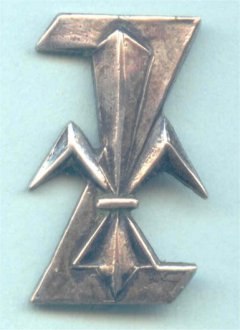
Badge of the scout's organization "Zawisza"
Zawiszacy were encompassed by the scout's educational program and underwent comprehensive training preparing them for participation in the future universal uprising. The service of the youngest Grey Ranks in the forthcoming uprising was codenamed "Mafeking". The name was derived from a town in South Africa, where, during the war, surrounded British general R. Baden-Powell organized auxiliary scouting service of boys which is considered as the beginning of scouting in general. In September 1943 "Pasieka" ("Apiary"), the Headquarters of the Grey Ranks developed secret manual called "Mafeking" for functionating "Zawisza".
The manual listed the following tasks for the "Zawisza" teams:
a) out of front communication
b) information scouting
c) traffic regulation
d) anti-aircraft defence and handling the airstrips
e) supervision and casual tasks
The manual was not about military communication but about communication between civilians and military or civilians and other civilians. The great emphasis was placed on self-reliant in hard conditions and self-initiative in the absence of contact with the military command. In order to be able to become a part of this service Zawiszacy needed to prepare themselves for over a year gaining appropriate skills and knowledge in the military field.
On 15 March 1944 thorough reorganization in the Warsaw's Standard of Scouts of the Grey Ranks ("Wisła" street) has taken place. In place of the three existing age groups - Assault Groups, Warfare Schools, and Zawisza - a territorial structure has been introduced.
6 blocs were formed, each of them corresponding to the 6 areas of the Home Army by which the Warsaw was divided in the Warsaw District of Home Army.
"Zamek" ("Castle") in the area of Śródmieście (1st Circuit of the Home Army),
"Cytadela" ("Citadel") in the area of Żoliborz (2nd Circuit of the Home Army),
"Reduta" ("Redoubt") in the area of Wola (3rd Circuit of the Home Army),
"Prochownia" ("Gunpowder works") in the area of Ochota (4th Circuit of the Home Army),
"Radiostacja" ("Radio station") in the area of Mokotów (5th Circuit of the Home Army),
"Bazylika" ("Basilica") in the area of Praga (6th Circuit of the Home Army).
The purpose of the bloc was to integrate individual age groups of scouts, facilitating natural advancement, providing the reserve for the oldest group. The good as it would seem at the beginning idea of creating blocs overlapping with the Home Army's circuits did not work out as well in practice which resulted negatively in the coordination of actions during the Uprising.
On the tenth day of the uprising, the youngest scouts undertook actions supporting the insurgents. One of them was a spectacular sending of eight two-person patrols of Zawiszacy. Scouts supplied with orders wrapped in cellophane, appropriate passes and passwords set off for action.
Out of eight pairs of scouts-messengers, only three reached their destinations. One of them crossed the Vistula, made contact with insurgents in Praga and returned the same way to the left bank. The second arrived in Włochy.
The hardest route to the Chojnowski forests and back was realized by two twin brothers Józef and Zygmunt Przewłocki ps. "Jacek" and "Placek". They crossed Czerniaków, Siekierki, Wilanów, partly through canals. All the way back and forth has taken them 21 hours. For their exemplary performance, they were awarded the Crosses of Valour. Unfortunately, a few days later one of the brothers "Jacek" died in the explosion of an anti-tank missile.
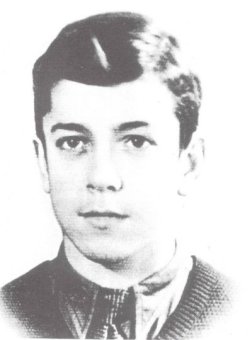
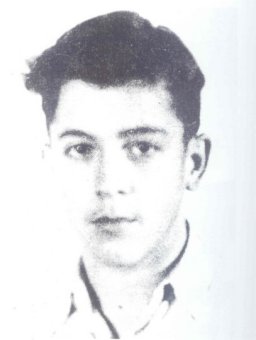
Józef Przewłocki a.k.a. "Jacek" and Zygmunt Przewłocki a.k.a. "Placek"
The initiative to create a Scout Mail Post came from scoutmaster Kazimierz Grenda a.k.a. "Granica", head of the second row of Headquarters of the Grey Ranks codenamed "Pasieka". By August the 2nd 1944 the first field post was organized in southern Śródmieście. Two days later the leader of Headquarters of the Grey Ranks scoutmaster lieutenant Stanisław Broniewski a.k.a. "Orsza" decided to set up a scout field mail for the whole liberated city.
Directly before the Uprising, there were 18 detachments (swarms) in the 6 blocs of the Warsaw Grey Ranks, gathering boys aged 12-15. During the last months before the Uprising, they were severely thinned by the recruitment of older Zawisza into Warfare Schools, Assault Groups or even scout battalions. Their overall number, however, was still substantial amounting approximately 1300 scouts.
Scoutmaster Kazimierz Grenda ps. "Granica" at the first moment relied on the concentrated before the Uprising Zawisza swarm of Western Territories, whose commander was sub-scoutmaster Zygmunt Głuszek a.k.a. "Victor". It consisted of about 40 scouts located in the stands in Aleje Jerozolimskie 25, later Hoża 13.
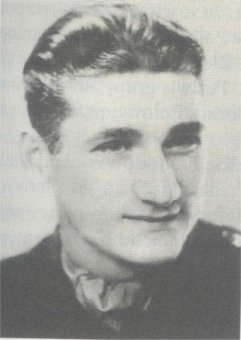
Sub-scoutmaster Zygmunt Głuszek a.k.a. "Victor"
By the August 6 "Pasieka" was reached by scoutmaster second lieutenant a.k.a. "Kuropatwa" together with a group of Zawisza with whom he spent the first days of the Uprising at Bracka 5. After the Field Mail was created he was appointed its leader.
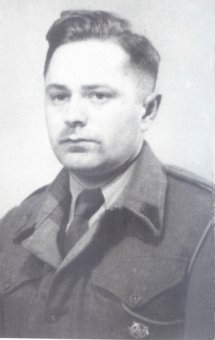
Scoutmaster second lieutenant Przemysław Górecki a.k.a. "Kuropatwa"
Rapidly establishment and dynamic development in all areas of śródmieście allowed Scout Field Mail to distinctly subdue the attempts of the military post network activity created in the northern parts of Śródmieście and Mokotów. Scouts from the beginning were aware of the situation of the civilian population and its need of communicating with the cut off families. As a result of discussions in both cases, the military services at first decided to cooperate and later to hand over their agenda to the Scout Field Mail. In the Śródmieście, authority and competence of scoutmaster "Kuropatwa" and his co-workers were fully approved.
The Scout Field Mail has become one of the biggest organisational phenomena of the Warsaw Uprising. Its creation was one of the symbols of the functionating Polish Underground State and self-organisation of the society under extreme conditions. Establishing the post in Warsaw in 1944 was a state-creating activity. It played a key role in maintaining communication between the people of Warsaw during the Uprising. On August 19 the merging with Military Field Mail, which was created on the first day of the Uprising, has taken place.
The Scout Field Mail which started its activity in Śródmieście quickly gained recognition and great popularity. The first information about its creation was the official announcement of the Polish Telegraph Agency published in the 19th insurgent daily newspaper "Rzeczpospolita" from 9th August 1944:
""At the initiative of the scouts, a postal service was launched in the fighting Warsaw which has been servicing almost all of the districts of the city for several past days. In each district, there are several mailboxes with an eagle and description P o l i s h P o s t. Boxes are emptied twice a day at 9 am and 4 pm. Mail users should know the following details: write briefly and clearly, write addresses legibly, civilians give the address of them and recipient, soldiers do not provide their address; letters of civilians are returned to senders in case of not arriving at the desired location, military ones are destroyed.
It is the responsibility of the inhabitants of each home to organise the points where the scouts can bring all the letters to their receivers."
Its functioning was sanctioned by subsequent orders of the Home Army command.
The order number 14 from 11th August of the Commander of the Warsaw District and simultaneously commander of the Uprising colonel "Monter" was fundamentally important for the organizers of the Scout Field Mail. This order in point "IO/VI Field Mail" stated following:
"On the 6th of June field mail was launched at the initiative of scouts in order to provide postal services in private correspondence between Home Army soldiers and civilians.
In the post traffic it is required to follow the instructions carefully and above all keep military secrets.
All correspondence should not exceed 25 words. Scout boxes deployed in various parts of the city (12 as of this moment) are boxes of the field mail."
This order officially sanctioned the organization and activity of post office founded by scouts. This was extremely important given the fact that parallel military mail organization was involved in military actions.
The order of the commander of the Uprising finally resolved this case in favour of the Scout Field Mail.
The order No. 20 from 20th August of the Commander of the Warsaw District of the Home Army colonel "Monter" at the point "7 IIV. Field Mail stated:
"In order to improve the work of field mail while preserving the military secrets, field mail numbers will be assigned to the specific districts and units of the staff. Commanders of the circuits and staffs will receive in the separate ordinance their own numbers of the field mail. For units deployed in the perimeter and individual cells of the circuits, the heads of staff will assign additional, sequential numbers written in the denominator of the number of specific field post. At the same time, I explain that failing to address letters in a way preserving military secrets and proper way of marking the number of field post will result in failure in reaching the addressee."
For the third time, the information about the post was given in the order No. 25 from 30th August of the Commander of the Warsaw District of the Home Army at the point "3/IV. Field Mail - explanation". It concerned orderliness-technical issues:
"Postcards and letters in the open weight range of up to 20g are allowed to circulate in the post office. Letters and postcards should be written in Polish, in a readable letter, and may not contain signed marks, cyphers etc.
Letters and cards are free of charge. Deliveries should be stocked with the exact address of the recipient and sender. Only the post office is allowed to stamp letters and postcards and it is forbidden to use any other stamps.
All stamps and prints of the Polish Post and for GG and others created during Uprising shall be immediately transferred to the Quartermaster of the District for the disposal of the postal authorities".
In the case of the Scout Field Mail, civil authorities working in the insurgent Warsaw have spoken. On August 20, "Announcement on the Postal Service" issued by the District Delegate of the Government "Ing. St. Kulesza" appeared:
"The Grey Ranks (scouts) have been authorised by me to organize mail for the civilian population similar to the field mail, operated by the Grey Ranks as ordered by the District Command of the Home Army in Warsaw on August 11, 1944. Because of this grave and generous contribution of the Grey Ranks, I would like to make a proper assessment by the society and the appropriate response to the scout mail guidelines."
There were 8 post offices operated by the Zawisza in the fighting city: some of them changed their headquarters during wartime.
1. Main Field Mail.
Head: scoutmaster second lieutenant Przemek Górecki "Kuropatwa".
Staff: Host of 6 scout-girls - segregate, cyphers + team of censorship - together about 10 people.
Mp. Świętokrzyska 28 - 6.VIII-15. VIII.
Pl. Napoleona (building of the Main Post) 16 VIII-2 IX 1944.
Wilcza 41 6 IX-2 X 1944.
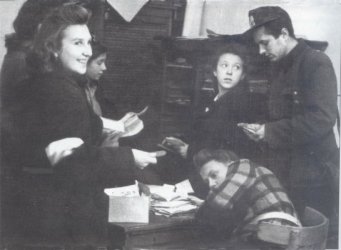
Sorting department in the Main Field Mail at Świętokrzyska 28
2. Northern Śródmieście Post Office.
Head: scoutmaster second lieutenant Przemek Górecki "Kuropatwa".
Staff: About 20 scouts.
Mp. Świętokrzyska 28 - 6 VIII-15 VIII 1944.
Pl. Napoleona- (like above) 16 VIII-l IX 1944.
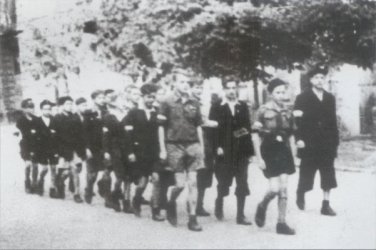
Post team of Zawisza on Jasna stree
3. Southern Śródmieście Post Office.
Organizer: scoutmaster second lieutenant Kazimierz Grenda "Granica", head: scoutmaster Władysław Olędzki "Papa", (scoutmaster Leon Jankowski "Jurand" from September).
Staff: 3 teams of the hive of "Ziemie Zachodnie", team of Tadeusz Kościuszko, 16 WDH of Zawisza Czarny. Together about 70 scouts.
Functionated until 2 X 1944
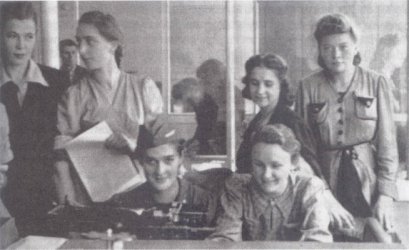
Scout-girls from Southern Śródmieście Post Office
4. Powiśle Post Office near Okólnik street - building of Conservatory.
Head: sub-scoutmaster Zbigniew Brydak "Krasnoludek". Staff: team of Zawisza consisting of about 20 members and host of about 7 scout-girls.
Functionated until 2 IX 1944.
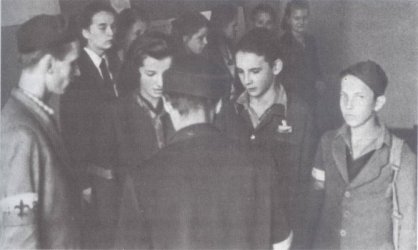
Check-in of postmen from Scout Field Mail Powiśle
5. Czerniaków Post Office - Czerniakowska st. 231 (building of ZUS).
Head: dh ćwik Baszyński "Cipek". Staff: about 18 scouts.
Functionated until 12 IX 1944.
6. Mokotów Post Office at the Tyniecka 26, later Krasickiego 29,, organised by 2 officers of the Home Army.
Scout supervision - scoutmaster B. Szatyński "Olgierd".
Staff: about 20 Zawisza.
Functionated until 20 IX 1944.
7. Post Office at Sienna 16.
Head: "Antek" - Zenon Komoński. Staff: about 16 boys and a few girls.
Functionated from 8 VIII to 28 VIII 1944.
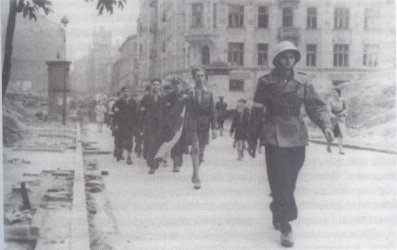
Team from the Sienna Scout Field Mail
8. Home Army's Post Office, Szpitalna 4.
Direct co-operation with the Main Field Mail operated by the scouts.
Functionated from 5 VIII 1944 to 8 IX 1994.
There were about forty mailboxes located in various locations of the city. They were placed on the front sides of houses, gates, and barricades. There were as many as 12 of them in Śródmieście. They were also placed in Powiśle and nearby Czerniaków. They were rare in Mokotów, for example, placed at the Command of the Square of V Circuit of the Home Army and at the units of the insurgent post at Tyniecka 26.
In the first stage of Scout Field Mail's activity mailboxes were ordinary boxes made from steel, wood or even cardboard attached to a stick or hanged on the wooden fence.
In some areas, post-occupancy mailboxes were used in a later period after painting "Deutsche Post Osten" (German East Post) and Nazi eagle mockingly called "crow". They have turned nearly useless, however, because it was impossible to find the keys opening them.
In the basements of the captured Main Post Office in Śródmieście, a storehouse filled with small red boxes of the pre-war post with inscription "Polish Post" and a big white eagle in the middle was found. Messengers from Home Army's Field Mail came across several boxes, inside the warehouse of the Main Post Office, designed for equipping military field mail during September 1939. These boxes were labelled "Insurgent Mail" and painted with the image of the white eagle or labelled as "Scout Mail" and painted with an emblem of green lily. A special guide for users was often attached to the mailbox.
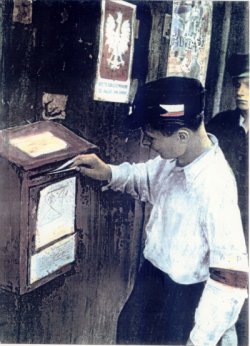
Mailbox of the Scout Field Mail
Boxes were placed near the quarters, hospitals, military commands, and near the "busier" streets. Later they have placed also in less accessible parts of the city in order to allow the entire civilian population to be able to use the services of scout mail. From the snippets of correspondence and addresses on the surviving correspondence, we can locate about 30 mailboxes of insurgent mail.
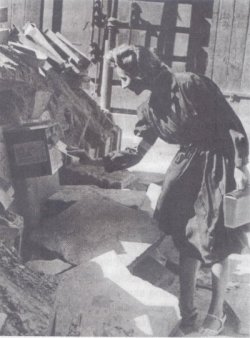
Mailbox of the Scout Field Mail on the Barricade
There were no mailboxes in the districts where there were no organised insurgent mail divisions, for example in the Old Town and Żoliborz.
Out of dozens of boxes of insurgent post, after the war, only two of them were found. One of them is placed in a worthy place of Warsaw Uprising Museum.
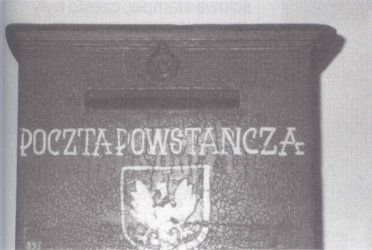
One of two mailboxes of the insurgent post found after the war.
Postal staff, not including censorship staff, often consisted of two to four people in each division. Depending on the number of consignments, auxiliary forces were mobilised in order to finish work on time and sort, disseminate and deliver correspondence as fast as possible.
To each post office, there were assigned squadrons of Zawisza commanded by the older scouts, mostly scout instructors in charge of leadership, boys acting as postmen. The heaviest burden of responsibility and work was placed on them. With bags full of letters, day by day they sailed among the ruins, barricades, passages known only to them through fences, basements, holes in the walls, often under murderous enemy fire in order to fulfil their scout duty. Zawisza as a part of the occupational preparations for the insurrectionary uprising thoroughly learned the topography of the city, which made them the main force of the insurgent post.
The letters were free of charge but a little cubby was placed under the mailboxes for voluntary fees in form of small payment, books, magazines and brochures which were later given to the hospitals for wounded soldiers and the civilian population. After the war, they were to be found in the form of library sets in the Western Lands, on the autochthonic, as a part of the repatriation actions, to which many of the Grey Ranks squads were preparing. Bandages and food were also accepted. For this form of payment in some post offices stamps with the words "Paid" were placed. Residents of the city were also generously assisting the postman - volunteers, giving information on the addressees or even helping to convey the letters.
After just a few days the Scout Field Mail has gained enormous popularity among civilians and soldiers of the local troops. Young postmen were greeted really warmly by the military units. They took and delivered letters directly from their accommodation places which improved and accelerated activities of both sides.
The Scout Field Mail has become a sensation of the fighting city. It has not only gained a lot of popularity because of its efficiency but also above everything else appreciation of soldiers and civilians waiting for contact with their beloved ones. In the streets, on the battlefields, in the basement shelters, young boys appeared in often incomplete scout uniforms with big bags filled with parcels and letters, with a lily on the insurgent band.
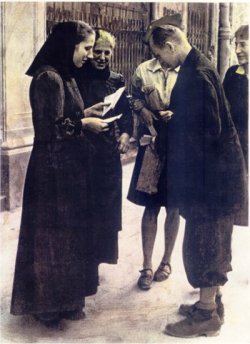
Delivering letters by the postman of Scout Field Mail
Proud of their service, persistent, inventive, energetic Zawisza, the youngest scouts of the Grey Ranks, the youngest soldiers of the Home Army, the youngest insurgents of the fighting capital city. Scouts created their own organizational and personnel infrastructure and were able to ensure efficient mail activity to the end of the Uprising. During the Uprising almost two hundred messengers were serving in the Scout Field Mail as a postman.
Immediately after launching the Scout Field Mail second lieutenant Przemysław Górecki a.k.a. "Kuropatwa" appealed to the youngest scouts in Warsaw:
"Zawisza
Anyone who has not yet reported to their instructors due to the difficulty of contacting them should appear near the mailboxes of Scout Field Mail during their emptying hours.
After checking all the data, the messenger will guide you to the appropriate district commands.
Kuropatwa
Commander of the Auxiliary Service"
The youngest scouts of the Grey Ranks massively responded to the appeal. "Zawisza" and scout-girls of the "Scout Emergency" were postmen of the Scout Field Mail in the fighting Warsaw. They were called carriers of hope. Each morning they have picked up consignments. Carrying heavy mailbags, they were sneaking routes known only to them constantly risking their lives, with letters and consignments for awaiting them impatiently recipients. They sent and received mail, emptied mailboxes. Often, they were the only links of families separated sometimes by only one street under fire.
During the first days of functionating of Scout Field Mail there was a small number of occupation stamps of General Government with made in the printing house at the crossing of Marszałkowska and Wilcza overprint with national emblem and text:
Insurgent Post - Warsaw August 1944
or
Field Mail - VIII 1944 Warsaw
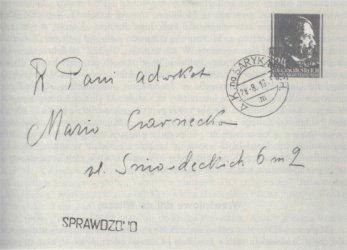
Letter with the stamp of General Government stamped with the stamp of the Scout Field Mail
At the turn of August and September 1944 in the Propaganda and Information Department of the Home Army's Warsaw District, the idea of printing out stamps of the insurgent mail was born. They have held a competition which resulted in the approval of the project of graphic artist Stanisław Tomaszewski a.k.a. "Miedza".
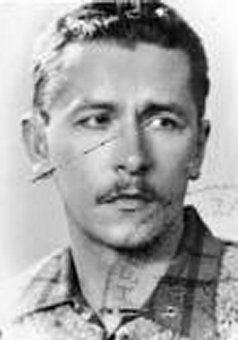
Stanisław Tomaszewski a.k.a. "Miedza"
Unmarked stamps were printed in five different colours corresponding to the five Military Districts by which Warsaw was divided. Assigning colours to the districts would help in segregation of letters in post offices. This idea, however, could not be realised due to the rapid loss of communication between particular districts of the city.
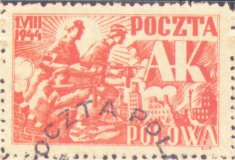
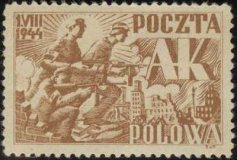
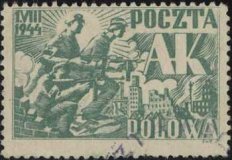
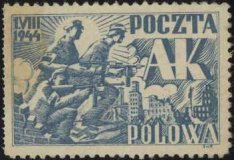
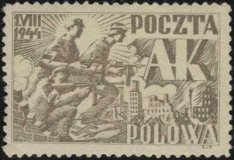
Stamps of insurgent mail by Stanisław Tomaszewski ps. "Miedza"
Stamps, 13 750 in total, were made by Military Printing Works which was quite an achievement, given that before the war stamps were printed on precise machines and plates of PWPW.
The entire printing was handed over to the scoutmaster "Kuropatwa", who on the September 2 delivered all of it to the branch at Wilcza 41. Once put into circulation they immediately gained great recognition.
Later stamp designed by Marian Sigmund a.k.a. "Nałęcz", the second winner of the contest, was printed.
A stamp issued in two colours presented two soldiers attacking the enemy tank on the barricade.
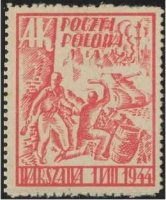
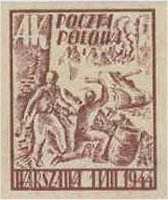
Stamps of the insurgent mail by Marian Siegmund ps. "Nałęcz"
Stamps of insurgent mail were put into in a difficult time for the Uprising. Wola, Ochota and Old Town have fallen, Germans were attacking Powiśle, fierce fighting soon broke out on Czerniaków. In this situation not, all letters were stamped.
On the first days of operation of Scout Field Mail, there were no postage stamps. Sub-scoutmaster Edward Maliszewski a.k.a. "Sikora" was given the task of making stamps for marking small format shipments. The first two designs were made of a halved potato in which the words Scout Mail and lily were carved with a pocket knife. This stamp broke up after a few uses.
Another third pattern was made from linoleum, a material commonly used by Zawisza in printing during the occupation. A small roller was attached to a large spool of thread with a handle attached. Rubber and soft metals were also used for the production of rubber stamps. Stamping of consignments has become a straightforward and easy task and the drawing of the stamp impressed very clearly. In the same way, other stamp designs were created, not only for the Wilcza branch. Scouts used a total of 10 postmarks with the inscription "Scout Mail" and a scout lily. The last round stamp designed by sub-scoutmaster "Sikora" contained apart from the inscription and scout lily the number "44" - the year of the outbreak of Warsaw Uprising.
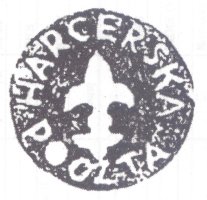
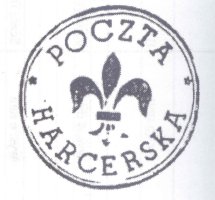
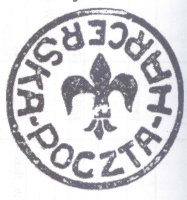
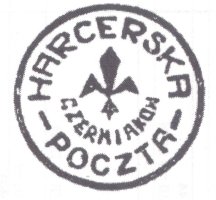
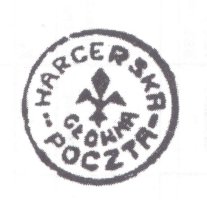
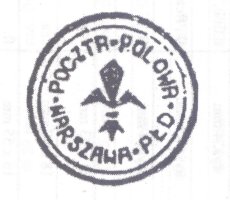
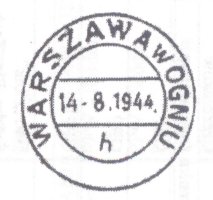
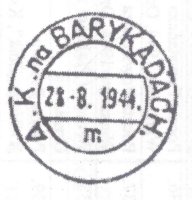
Examples of the Scout Field Mail stamps
The correspondence provided within the Scout Field Mail was subject to certain rigour. Correspondence was limited to 25 words and was subjected to censorship. Letters were analysed by the Information and Investigation Department of the District Command of the Warsaw Home Army in order to study social reactions.
Under conditions of insurrection, military censorship was a necessity. The danger of deliberate or even more frequent unintended disclosure of the military secrets was in the military situation of Uprising very dangerous. An appropriate order of the Government Delegation was issued on this matter and the necessary control apparatus was set.
At the acceptance of the insurgency staff, the role of censors was held by people appointed by the Grey Ranks. They were generally families of the "postmen" or scout insurgents. That is why the civil censorship team consisted of Zofia Marciniakowa, widow of the martyred in Gross-Rosen head of the Grey Ranks scoutmaster Florian Marciniak a.k.a. "Jerzy Nowak", parents of scoutmaster Przemysław Górecki a.k.a. "Kuropatwa". At the Scout Field Mail's Wilcza 41 branch the censors were: scoutmaster Kazimierz Grenda, initiator and instructors Krzysztof Wierusz-Kowalskia.k.a. "Rakowski" and sub-scoutmaster Edward Maliszewski a.k.a. "Sikora". Aniela Urbanowicz and Zdzisława Bytnar - mother of Janek Bytnar a.k.a. "Rudy", the main character of "Kamienie na Szaniec", also entered censorship team.
Censors made sure that the senders did not reveal insurgent force's locations, their armaments etc. The content of the letters usually did not exceed ordinary information: about a health condition, searching family members call for help with the sick mother or little children left for a moment.
The censorship apparatus worked with great effort not to stop the flow of letters awaited by the people. Hundreds of letters were received by the censorship located in the basement near the building of the Main Post. After censoring they were stamped with the stamp made by the engraver with the word "censored" and handed over to the postmen for delivery to the addressees.
Letters were short, sentences simple and full of care. No superfluous words. No sign of despair. This correspondence gives a unique image of the Warsaw Uprising seen by the eyes of sisters and mothers of soldiers. It shows the situations of families divided by the battlegrounds and solidarity of citizens taking care of the fate of their neighbours.
Here are some of them:
6-8-44 Dear Miss, please give me any information about my mother Maria Skórzewska and aunt Natalia Platonow. When did they close the shop on the day of the uprising and where they might probably be.
10 VIII Dear son! We are on Kredytowa in the basements. We are safe and sound. We are waiting for your letter. Kisses. Mother.
11 VIII Dear, we are constantly worried about you since the last letter. Your mother lost her glasses, she cannot write to you. She orders you to watch yourself, eat well and sleep all you need. She cries all the time. She is worried about you. Her brother Tolek has died. Today she has learned about it. We kiss you. Marta.
August 16, 1944, Dear Sir or Madam, with all of our hearts we thank you for the medicines donated for the baby (
). In the near future, we will pay back for goodness and memory. Yours faithfully. Budzyńscy.
18/8 44 Dear Mr Dobrzański, thank you very much for your hospitality. Yesterday I went back to the Żurawia. Everybody is safe. Last week I have been to Mr Żakowski. Greetings and bows I send to You. Zamojski with his wife.
20 VIII Mr Antoni! Your son is wounded. He is at our house. My wife takes care of him. 9 AM. Woźniak
24.08.1944 Dear Beatka, last week I have sent you a letter. I have no news from you. Six people came to our flat. All friends have stopped by for some time. Conditions forced them to do so. I have also written to Grażyna. Write a few words. Marek.
5 IX Rysiek! Everything is all right. My leg is in slates. I will write in the evening. Cancer. Keep this sheet of paper.
I am concerned about the fate of Mr and Mrs Sawicki, I kindly please to inform me about it. On August 20, Mr Jan informed me that they are living but they are located in the middle of a fight. Yours sincerely, Józef Zaremba Śniadecki 11m. 7, 25 IX 1944.
On the first days of the uprising, people were writing on the postcards and letters were sent in envelopes. Every day, however, reduced the chance of finding the paper. So, people wrote on scraps, sometimes the size of a tram ticket. Today the surviving letters, similarly to the stamps produced for Scout Field Mail are philatelic unique.
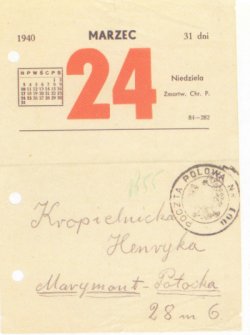
Letter of the field mail transferred through the canals from Śródmieście to Żoliborz
The most dramatic were the letters of the insurgents from barricades who during the desperate fights with Germans were increasingly aware that their barricades are doomed and their fate is sealed. Scout-postmen also died. One of the first of them to die was a 16-year-old Zbigniew Banaś "Banan" fatally shot in Powiśle by a German sniper.
During the first day of the operation of Scout Mail, the scouts mailed over 900 letters. Later the number of daily shipments varied between 3 to 6 thousand letters and reached its peak on August 13 when 10,000 letters were received. In addition to the letters scouts also carried writings and newspapers with information. Every boy or girl received from a few to a few dozens of letters during each course.
The post covered in its range Śródmieście and Czerniaków. Insurgent postmen also reached the districts cut off by Germans. Letters were delivered two times a day. It might sound unbelievable but letters to the addressees in the same district came on the same day and to the districts cut off by Germans within 48 hours. Scout messengers reached the Old Town and Mokotów by steady canal routes. This efficiency can be envied by today's Polish Post.
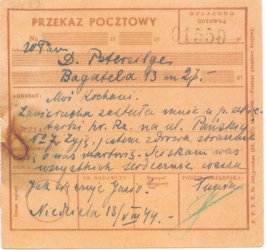
Unusual letters of field mail written on a shipping letter
By the end of the Warsaw Uprising postmen in scout uniforms carried over 200,000 consignments. Many of them died or were injured.
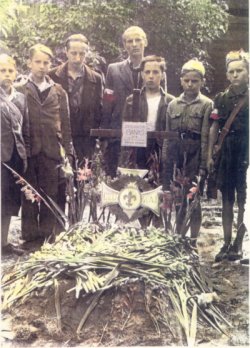
The funeral of Zbigniew Banaś a.k.a. "Banan" - scout killed in Powiśle
On August 6, 1944, Scout Field Mail was incorporated with entire personnel to the Home Army and since then the writing "Scout Mail" has been replaced by "Field Mail".
At the beginning of September 1944, the Main Post Office together with the Headquarters of the Grey Ranks - "Pasieka" was transferred to the post office at Wilcza 41. On October 2, 1944, the last insurgent scout assembly took place. In the courtyard damaged by the shrapnel appeared members of the decimated in Wola, Old Town, Czerniaków and Mokotów scout battalions: "Zośka", "Parasol" and "Wigry". There were only several dozens of boys and girls. On the remaining wings of the square, there were scouts from the auxiliary services, among them the youngest "Zawisza" of the Scout Field Mail. Nearby graves with crosses and tablets with surnames and pseudonyms of those who left the scout ranks for eternality were located.
The orders of the commandant of the city, general "Monter" from 1st October 1944 and the chief of the Grey Ranks scoutmaster "Krzemień" (Stanisław Broniewski) were read. The order of the chief of Grey Ranks included nominations for military and scout ranks as well as awards and honours. On the list of awarded were 9 "Zawisza" honoured with the Cross of Valour.
Words coming from the speeches were spoken - about scout service, about difficulties and sacrifice, about the love of the homeland, about fight which was still taking place in the country. About a day to come when they will meet again in a free country which would have to be rebuilt and lifted from ruins, which would require sacrifice as big as during the fights on the streets of the capital city.
The last report was made. Team heads passed the information about the status of their teams from a few weeks ago and their present state. Absent - those who passed away. Their nicknames were spoken. A list of those who died in unknown circumstances was also long. Without any news. The inhabitants of the property started to surround scouts with an increasingly tight circle of men and women. At the end of the meeting, all scouts standing on guard repeated after the chief of the Grey Ranks words of the scout's vow: "I have a sincere will for my whole life..."
The activity of the Field Mail has ended on October 3, the day of surrender of the Warsaw Uprising. Stamps with the white eagle and the ones with scout lily were buried next to the graves of the fallen. The Scout Mail Archive was buried overnight in metal boxes in the property yard of Wilcza 41. After the war, it was extracted by Służba Bezpieczeństwa (Security Service) and its content is not disclosed up to this day. Some witnesses claim that it was destroyed by UB in the fifties. Its absence makes it difficult to summarise the achievements of the scout mail.
Scouts performed their tasks up to the last days of the Uprising. After its fall those who were younger than 16 years old came with civilians, older ones came with the army. "Zawisza" who had contact with their families returned to them. Instructors showed particular concern for those who could not return to their homes, districts which were previously captured by the enemy. They were given warm clothes and shoes, blankets and essential items of everyday use. Many of the scouts came out of their homes on a hot August day only in shorts and light sweatshirts.
On the day of departure special gathering in all teams has been ordered. It was a thorough overview of everything that everybody has owned. Anything that could have affected the boys during the possible revision by the Germans: scout badges, insurrection bands, lyrics, notes with addresses and names were to be placed in a tin box that had been buried in the basement. Upon the return to Warsaw, the deposit was to be excavated and everyone was to receive their belongings back.
Each of scout-postmen had a philatelic rarity - stamps of the Field Post of Home Army, one series of 5 pieces one stamped and the second one stamp less which they received in memory of the postal service. Stamps in these numbers in case of revision would be an unmistakable proof of being involved in the insurgent fights in the capital city. Despite the appeals, requests, orders to give the stamps back made by instructors no-one deposited not even one stamp. People responsible for searching through scouts' bags were unable to find cleverly hidden stamps, so they decided that if they did not find them, the Germans also will not.
"Zawisza" often went either to the camps or to work in German factories while their older colleagues to oflags. After the war, most of them returned to Poland. Several dozens of them were closed down in communist prisons. Frequently with German criminals.
On the front side of the house at Wilcza 41 there is a plaque commemorating the Scout Field Mail.
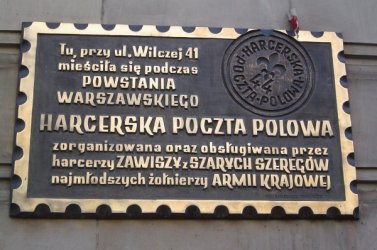
Commemorative plate at Wilcza 41
Plate commemorating the actions of the Scout Field Mail operated by Zawiszacy on Mokotów located on the building at Tyniecka 26.
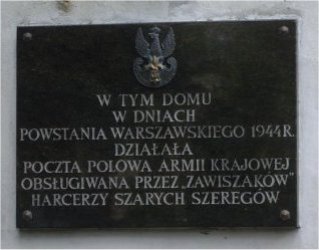
Commemorative plate at Tyniecka 26
In August 2010, the name of the Warsaw Uprising Field Mailbox was given to a park located in the Warsaw districts of Żoliborz and Bielany.
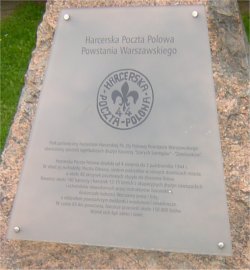
Commemorative plate in the Scout Field Mail of the Warsaw Uprising Park
One of the permanent exhibitions of the Museum of the Warsaw Uprising is dedicated to the Field Mail.
The story of the Scout Mail did not end during the capitulation of the Warsaw Uprising.
After his return to Mokotów, Stanisław Giers - a soldier of the Home Army regiment "Baszta" in February 1945 found several dozens of letters stamped with the stamps of Scout Field Mail on one of the streets of the district. His wife, injured in both legs during the Uprising, while walking on Tyniecka street has found next to a broken house sheets of paper, envelopes with addresses and postal cards lying in mud and snow. Many of them were stamped with words "Scout Field Mail". Mr and Mrs Giers carefully collected scattered documents. During the Uprising there was a Mokotów branch of the Scout Field Mail operated by Zawiszacy located nearby. In the course of the heavy fights going on in this area, the scouts probably needed to suddenly leave their post and could not take all the letters, or maybe during the evacuation of the post office one of the boys transporting letters to the new point was hit by an enemy bullet.
After gathering about 70 letters, cleaning them off the mud and drying them Mr Giers decided that they should be delivered to the addressees or senders. He went to the addresses visible to them. Unfortunately, most of the houses were destroyed or burned and their tenants were either in camps (they could not go back because of the ongoing war) or their fate was unknown. He put the secured letters in the drawer hoping that at least a part of them would reach their destinations.
In 1956 during the excavation of the ruins of the Main Post from the side of Warecka street, the workers found a skeleton of a scout with a bag containing several hundred letters from the Uprising period. Those letters were brought to the well-known philately merchant p. K. de Julien with the intention of selling them. P. de Julien who has lost his son in the Uprising bought the letters and then made a list of them with surnames of addressees and senders and announced it in the popular Warsaw press setting a 3-month deadline for receiving letters. Most of them were received, the rest have created a commemorative collection.
In the spring of 1967 Jerzy Kasprzak a.k.a. "Albatros", a journalist, published memoir devoted to the activity of "Zawisza" in Warsaw in the scout magazine "Świat Młodych". During the Warsaw Uprising as a 14-year-old boy, he was one of the postmen of the Scout Field Mail. Seven months later he has received from the editorial team of "Drużyna" a dozen not delivered during the Uprising letters of the Scout Field Mail handed over by Mr Stanisław Giers. A few days later several dozen letters were personally delivered to him by Mr Giers. After unrolling the paper parcel yellowed post cards, sheets of paper from notebooks with few words and address written on them and scraps of paper with words scattered across the desk. Stamps of the Southern Śródmieście branch of the post were located on them. All with addresses in Mokotów. Zawiszak Jerzy Kasprzak remembered "Kuba" from his team going down to the canals with a bag filled with letters and the days of futile waiting for his return from Mokotów...
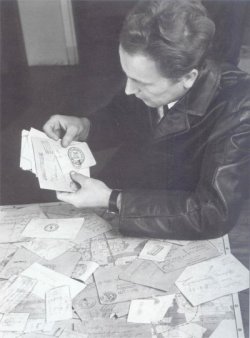
Jerzy Kasprzak a.k.a. "Albatros" with found letters
Information about the found letters reached the members of the Warsaw Historical Committee "Zawisza". An important meeting has taken place in the evening. The organisers of "Zawisza" and former Zawiszacy - postmen looked at addresses with care:
- Narbutta, Rakowiecka, Fałata, Wiśniowa, Asfaltowa were controlled by the enemy from the first days of fights. Germans transferred the population to the camps but also killed many people on the spot while burning houses. Zawiszacy could not reach there with the letters. Those letters have the note: "the area controlled by the enemy" ...
- Lower Mokotów in the course of heavy fights was being passed from hand to hand. Many of the inhabitants were able to leave their homes in time and slip out of the city. From these streets zawiszacy carried the letters back with notes "return, the addressee gone" ...
- Some of the houses indicated by the addresses were bombed or burned...
Slowly a reason for letters not being delivered started to become clearer.
It was decided that the letters had to be delivered to the addresses after nearly a quarter of a century. The task of searching addressees or senders in almost completely different in terms of the topography city was taken on behalf of the colleagues - Zawisza, the postmen of Mokotów branch of the Scout Field Mail!
Peculiar searches have begun. Addresses of the letters did not facilitate these efforts. Many of the notes placed on the letters were made back in the Uprising: house is burnt, an area controlled by the enemy, no access etc. Letters are full of anxiety about the fate of families, written on various pieces of paper, the testimony of those dramatic days, often the only trace of somebody's tragedy. On many letters, there are only numbers of Field Mail of the insurgent troops. Especially difficult are the names of women who are married today.
Despite this, letters reach either addressees or senders. The search campaign included not only Warsaw but also other cities of Poland. Its details are described by Jerzy Kasprzak in the book "Tropami powstańczej przesyłki". The author after twenty-four years went out with the bag filled with insurgent letters to the streets of Warsaw. During the first days of the action with the help of the old Warsaw caretakers (who turned out to be "walking address books"), telephones and editorial car, thanks to which wandering the streets of Mokotów, Śródmieście, and Ochota was possible, he managed to reach many of the searched families. Emotions, tears, and joys accompanying the acceptance of the letters containing news from nearly a quarter of a century ago, from days of glory and pain, bravery and tragedy, days which become one of the most heroic and at the same time the most dramatic events of the Polish history.
The action of delivering letters from the days of the Warsaw Uprising lasted several years. At that time there was a real chain of people and institutions of the good intentions. Those who have become happy recipients of news from a quarter of a century ago were looking at the other letters with great care and engagement trying to help to find other addressees or senders. Many mass media informed about the action of delivering insurgent consignments: press, radio, television. As a result of their activities, additional people come to receive their letters. Very often the ones that reported in were families of the dead addressees or senders. In the course of the delivery of letters, the author received in his editorial many phone calls from families who asked if there was no news of their loved ones which disappeared during the tragic days of the Warsaw Uprising.
In 1971 then Communication Minister prof. Edward Kowalczyk, Warsaw insurgent in the weekly "Stolica" announced an appeal to messengers of the Scout Field Mail to report to him. He wanted to obtain documentation about the operation of this extraordinary mail from the Museum of the Communication and to get to know the fate of its members, especially girls.
The appeal was not ignored. More than thirty people were found (some of them self-reported) - former messengers of the Scout Field Mail from the days of Warsaw Uprising. The minister met them on the occasion of the Day of the Messenger. All the participants of the meeting were decorated with the Gold Badge of the Meritorious Worker of Communication by the minister.
They have presented to an album to the minister which was illustrating the postal service that they had performed during the Uprising: several documentary photos, one original, not delivered the letter (postman found only ashes instead of a house) and several photocopies of letters with various postage stamps used at that time.
In the year 2008 whole Poland was experiencing emotions connected with buying a collection of insurgent letters from 1944 on auction. The collection was auctioned by the philatelic - numismatic auction house Ulrich Felzmann Briefmarken Auktionen in Duesseldorf. It consisted of 123 memorabilia: letters, envelopes, and stamps from Field Mail of the Home Army and Scout Field Mail. Experts who studied the authenticity of the collection in Germany recognised that except for the three of them the rest was authentic.
Museum of the Warsaw Uprising decided to buy the collection for 190 thousand euro. The purchase was financed by Telekomunikacja Polska and PKO BP. The costs of transporting the collection were covered by the Ministry of Culture.
Under the museum's signature P/6192 it has formed special exposition at the Warsaw Uprising Museum. Based on the scans of letters it was possible to compile more than one hundred surnames and place them on the www.1944.pl website for a general audience. Perhaps someone will recognise their letter written during the Uprising to their loved ones.
On the mezzanine of the Warsaw Uprising Museum on the doorstep of the Small Insurgent Room we can often find a sign: "MUSEUM LESSON IN SESSION - DO NOT DISTURB". The location of the hall and its interior are as if especially moved away from the horrors of war, traumatic events, and experiences. It is designated for children and tells the story of the youngest participants of the Uprising. About those who had to be protected from the fights but which also had to be permitted to serve. This service for the youngest members of the Grey Ranks, Zawisza, was mostly in the Scout Field Mail.
In this room children according to their age are learning the history and values of the insurgents of 1944. Among many toys and games from that era, children can draw, watch a replica of insurgent theatre, build a barricade or imitate their peers from Scout Field Mail using exact copies of postage stamps. Instructors of the didactic section which takes care of the Room of the Small Insurgent show children the reality of the fighting city while stressing the efforts of the adults to protect children in insurgent Warsaw from the ubiquitous cruelty of war.
At these museum lessons children, fifth-graders and sixth-graders sometimes arriving in coaches from distant parts of the country, having an opportunity to meet a real insurgent, then their peer, scout from the field mail, a messenger in the insurgent squad or guide in the underground canal. Out of almost two hundred messengers - postmen of the Scout Field Mail from the days of the Warsaw Uprising still lives about half of them.
A lot of interesting information about the Scout Field Mail can be found in these publications:
1. Jerzy Kasprzak "Albatros" - "Tropami powstańczej przesyłki";
2. Stanisław F. Ozimek - "Poczta powstańczej Warszawy".
Maciej Janaszek-Seydlitz
translation: Michal Chmielnicki
Copyright © 2017 SPPW1944. All rights reserved